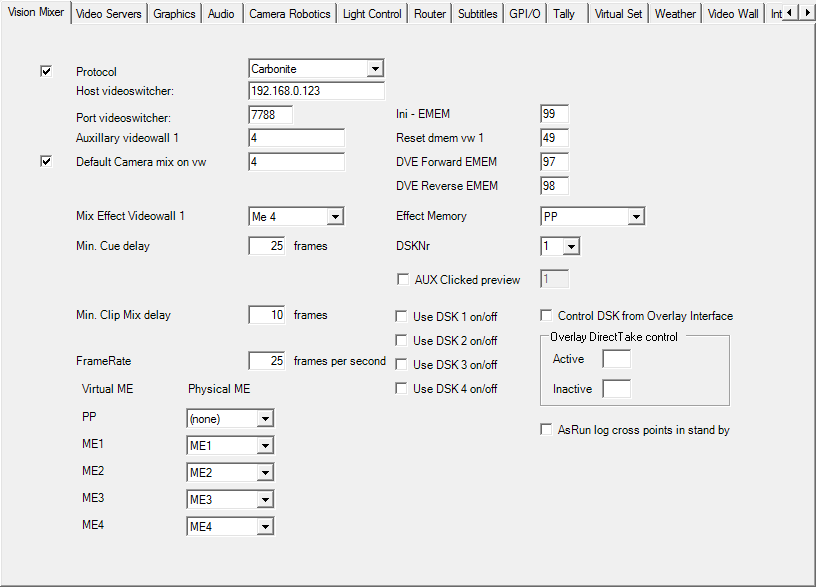
Viz Mosart Administrator Guide
Version 3.9 | Published November 04, 2019 ©
AV Automation Devices - Vision Mixer

Settings that are required for Viz Mosart to effectively control the Video Mixer, are outlined in the list below:
-
Protocol (check box): Check the box to enable video switcher control.
-
Protocol: Select a protocol supported by your switcher:
-
GVG200: GVG/Philips/Thomson
-
GVG4000: Ross Synergy
-
GVG4000 V2
-
GV CPL
-
GV DD35
-
GV KAYENNE PRIMARY
-
GV KAYENNE SECONDARY
-
GV ZODIAK
-
KAHUNA: Snell Kahuna
-
MASTERPIECE
-
NOVA700: Echolab
-
SONY: Sony compatible video switchers
-
SONY BVS: Support for legacy SONY DVS/BVS 300 series
-
SONY MVS: An extension to the protocol for the SONY MVS8000
-
SONY SERIAL TALLY
-
VizMos
-
Carbonite
-
TriCaster
-
-
Comport videoswitcher: The serial port the video switcher is connected to.
-
Host videoswitcher/Port videoswitcher: Defines the IP and port the video switcher is connected to.
-
This labeling on the settings page depends on what type of mixer is selected.
-
Host / Port is valid for mixers that are using TCP/IP protocol, or a com-port for serial port communication, or a host- or client-port for UDP.
-
Com-port / Host-port labeling depends on the mixer model. The GVG CPL driver uses UDP protocol and it has an additional client port property used for receiving callbacks.
-
-
Auxiliary videowall 1: This is the auxiliary output from the video switcher to the video wall.
-
Default Camera mix on vw (check box): Check to enable the default camera in program when entering video wall mode.
-
Default Camera mix on vw: Enter the camera number you want to use as the default camera in program when entering video wall mode.
-
Mix Effect Videowall 1: Select the ME to use when enabling mixing in video wall mode.
-
Min. Cue delay: Value in frames which sets the minimum delay before Viz Mosart cues the next template in preview.
-
Min. Clip Mix delay: Value in frames which sets the minimum delay from starting the server to starting the video switcher transition.
-
FrameRate: Specify the number of video frames per second for the system.
-
Ini-EMEM: Initial register to recall when starting the automation.
-
Reset EMEM vw 1: Register to recall to normalize the ME before entering video wall mode. (EMEM may be interchanged with other MEMs, like for instance: DMEM)
-
DVE Forward EMEM: EMEM to recall for running DVE forward (not supported by Sony).
-
DVE Reverse EMEM: EMEM to recall for running DVE backward (not supported by Sony).
-
Effect Memory: ME to use when recalling registers for Effect use.
-
DSKNr: Downstream keyer to use for the DSK on/off functionality.
-
AUX Clicked preview (check box and number): Check the box to enable AUX clicked preview, and specify the AUX bus connected to the preview monitor. When activated, it is possible to click an element in the Viz Mosart rundown, to preview the source on the monitor, via the specified AUX bus.
-
Use DSK n on/off: Enable or disable the on/off functionality for DSK 1-4.
-
Control DSK from Overlay Interface: Check box to enable DSK to be on only when overlay graphics is present.
-
Overlay Direct Take control:
-
Active: Viz Mosart will run the Direct Take entered here when an overlay graphic goes on-air.
-
Inactive: Viz Mosart will run the Direct Take entered here when an overlay graphic goes off-air.
-
-
AsRun log cross points in stand by (check box): Check box to set AsRun log in stand-by.